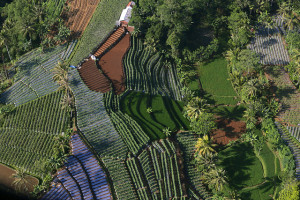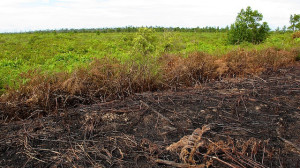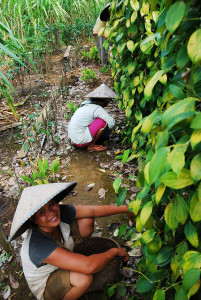
Adapted from CIFOR’s Forests News
Research on agroforestry is a big part of the CGIAR Research Program on Forests, Trees and Agroforestry (FTA). A new FTA study shows that by converting to agroforestry, farmers in Indonesia could reap major environmental, economic and social benefits. But many are not familiar with this practice and adhere to swidden agriculture. Kate Evans spoke to CIFOR scientist Syed Ajijur Rahman about his recent study and solutions to the problem.
Swidden is a farming system in which land is cleared for agriculture, mostly using fire. In some cases a rotational system is used, where an area is farmed for a few years, then left fallow to regenerate; in others, the land is cultivated continuously.
Both types occur in the Gunung Salak area, and swidden is deeply rooted in the culture of the communities there. However, the farming technique can contribute to environmental problems associated with deforestation, says Syed Ajijur Rahman, lead author of the study by the Center for International Forestry Research (CIFOR), Bangor University and the University of Copenhagen.

Farmers on the slopes of the imposing volcano Gunung Salak, near Bogor in Indonesia, traditionally practise swidden agriculture, growing rice, maize and cassava in the rich volcanic soil.
“Small-scale landslides on the swidden slopes are a big problem in this part of Indonesia,” Rahman says. “The loss of forest cover and the degradation of the remaining forest can greatly increase soil erosion on these steep slopes.”
Swidden isn’t necessarily unsustainable, but rapid population growth in this part of Java means more and more people are farming in a smaller area, increasing pressure on the land.
In the study, Rahman and colleagues from Bangor University and the University of Copenhagen assessed the potential of an alternative agricultural practice – agroforestry – and found that it holds great promise for the Gunung Salak area.
Farming trees and crops together could be a triple win solution for rural farmers in West Java – increasing incomes, enhancing land tenure security and reducing deforestation and forest degradation.
A triple win

Agroforestry means integrating trees into agricultural landscapes. In Gunung Salak, the most popular agroforestry systems are tree plantations of teak timber or durian fruit, with other food crops – maize, yam, cassava – grown beneath the branches.
The study found that in this community, these two agroforestry systems were more profitable than swidden cultivation. Teak was especially lucrative – farmers practising teak-based agroforestry made almost three times as much money as swidden farmers did. And the benefits are not just economic.
“When we talked to the farmers, they said the people who have a teak-based system have more monetary value, and they therefore have a little bit higher social status than other farmers,” Rahman says.
Planting trees may also give farmers stronger tenure rights to their land. Farmers in Gunung Salak often don’t have a certificate of land ownership, Rahman says, and that leaves them vulnerable to land grabbing by powerful actors.
“In the swidden cultivation system they may leave the land fallow for a few months to a few years – and during this time, other people could take their land. But if they have agroforestry, the trees are more permanent, and that can give them more permanent rights on their farms,” he says.
The environment – in particular the surrounding forest – also stands to benefit. Tree crops help secure the soil and prevent landslides. Reducing the need to burn off minimizes the chance of wildfires. And a key element of forest degradation – firewood collection – is also lessened when farmers combine tree crops with agriculture.
“Many farmers in this area don’t have money to buy the gas cylinders, so they have to rely on firewood for cooking,” Rahman says. “So the easiest way is to go to the forest and collect it. Sometimes they cut the very young trees from the forest, causing forest degradation.”
Farmers with an agroforestry plot, on the other hand, must prune their trees regularly, giving them a ready supply of firewood. “It might not meet 100 percent of their firewood needs, but even if it’s a 50 percent reduction in going to the forest, that will have a positive impact,” Rahman says.
Obstacles to overcome
Yet despite these economic, social and environmental benefits, at the time of the study in 2013, the number of farmers practising agroforestry was small. In some cases, the reason was cultural. Farmers have practiced swidden for generations, and don’t see the need to try something new.
Many would be interested in making the transition, though – they just need a little help. “The farmers who are interested need support by the government or by a flexible credit policy by the bank so they can get the initial capital to start agroforestry, to fund the first year,” Rahman says.
They need technical support, too. “Many farmers don’t have the knowledge – they have to know which trees are suitable for this specific kind of land, how to market agroforestry products, and how to manage the trees on their own farm.”
The interventions needed are small, Rahman says – meaning there’s a clear opportunity for governments and NGOs to make a big difference with a relatively small investment.
“Local farmers would likely have more income and could support their livelihoods better. There would be more tree cover in the agricultural landscape, which would reduce erosion. And farmers wouldn’t need to travel to the forest to clear more land, they could stay in one place,” Rahman says.
“If we want to sustain the agricultural system in the landscape scale, then we should motivate more farmers to practice agroforestry.”











